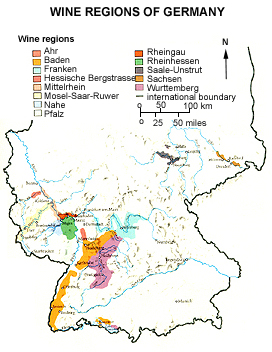| |


The white grape variety that forms the style benchmark in Germany is Riesling. It has a great capacity to ripen well in warm autumns, and thus takes full advantage of the QmP levels. Indeed, it could be said that the QmP law was framed around Riesling. As new varieties were developed, Riesling lost ground to more prolific and easy to grow vines.
Riesling is one of the world's classic vines and is described in the chapter on grape varieties. In Germany it occupies the best sites: the steeper river-valley vineyards such as those in the middle Mosel and Rheingau. These sites provide the good exposure to the sun, and the autumn warmth, which suit Riesling, which has a long ripening period.
The other classically German white wine variety is Silvaner. It is most associated with the Franken region, but in fact has its biggest plantations in the Rheinhessen. It can make concentrated, lively and long-lasting dry wine, but only when grown in good sites and when a low yield is taken from the vines.
|
|
|
|




